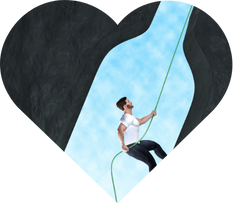When psychiatrist and addiction researcher Nora Volkow made the neurological patterns of addiction visible, the perspective shifted: it is not a moral failing, but rather an interplay of the brain, psyche, and environment. This outlook helps high performers recognize a blind spot: substance use is often not a recreational error, but an echo of internal conflicts – stress, shame, perfectionism. Understanding this not only helps regain control, but also clarity, energy, and self-management.
Substance use is rarely isolated. It interacts with inner conflictsconflicting needs, values, or emotions that create tensions, for example, the desire for achievement alongside the fear of failure. In the short term, substances dampen tension and negative affects through reward pathways in the brain. However, in the long term, they amplify conditioned triggerslearned stimuli that provoke cravings, increase irritability, and shift personal stress tolerance. Psychoeducation – the targeted understanding of one’s own patterns – creates distance between impulse and action. Self-compassion is not a "soft skill," but a performance-relevant regulatory mechanism: it reduces self-devaluationharsh, critical self-judgments, which often drives the cycle of shame and consumption. Recognizing the mechanics provides options for action: not to fight against, but to steer.
Psychoeducation shows in AOD settings that psychological distress can decrease – a direct plus for cognitive capacity, sleep, and decision-making quality [1]. Self-compassion and mindfulness correlate with higher willingness to change, a crucial predictor for relapse prevention [2]. For high performers, this means: less mental "noise," more stable executive functions, better emotion regulation, and thus consistent performance. Importantly, changes often first occur in experience (less distress) before objective behavioral measures become visible – an early sign that the system is recalibrating [1].
A psychoeducational intervention in an outpatient setting for individuals with complex needs proved to be practical and accepted. Core finding: psychological distress significantly decreased until program exit; changes in quality of life and substance use were not yet clearly measurable on average, although some participants reported reductions [1]. Relevance: Emotional relief is often the first marker of successful regulation and can create the foundation for sustainable behavior change. Additionally, a cross-sectional study with structural equation modeling analyses demonstrated that self-compassion directly enhances willingness to change and is additionally mediated by mindfulness. The motivation to compensate for perceived inferiority also influences willingness to change – indicating that addressing self-worth conflicts is therapeutically central [2]. Taken together, this results in a path-dependent model: Mindfulness promotes self-compassion; both reduce self-devaluating dynamics and increase willingness to change – a mechanism that closes the gap between insight and behavior.
- Keep a 14-day trigger log: Record time, context, emotion (0–10), bodily sensations, and action. Goal: recognize patterns, not evaluate. Benefit: visible "hotspots" that you can specifically defuse. Rely on evidence that psychoeducation reduces distress and promotes engagement [1].
- Micro-psychoeducation in daily life: 5 minutes per day for a “What-happened-before?-protocol” after each strong craving. Three questions: What thoughts? What feelings? What consequence? This mini-reflection cultivates a meta perspective and decouples stimulus-response [1].
- Self-compassion in three steps (60 seconds): Naming (“This is hard”), Normalizing (“Difficulties are human”), Supporting (“What would be helpful and kind right now?”). Goal: Interrupt shame spirals, strengthen willingness to change [2].
- Mindfulness intervals instead of willpower marathons: 3× daily 3 minutes of breathing focusing on bodily sensations. Effect: Increased mindfulness, which enhances willingness to change through self-compassion [2].
- "If-Then" plans for high-risk situations: If trigger X arises (e.g., evening overstimulation), then action Y (10-minute walking meditation, cold-warm shower, brief social contact). Psychoeducational clarity + concrete implementation intentions facilitate transfer [1].
- Performance-oriented reframing question: “What performance am I protecting by acting regulated rather than impulsively right now?” This cognitive switch leverages high-performer motives without triggering self-devaluation – in light of findings on self-compassion and compensation for inferiority [2].
- Check-in with professionals: Schedule a short, regular 1:1 format (digital/analog). The study showed acceptance and benefits of flexible individual offerings – use this structure as an accountability framework [1].
Inner conflicts do not disappear through harshness, but through clarity and compassion. Start today: 14 days of trigger logging, 3×3 minutes of breathing, and a daily 60 seconds of self-compassion. It requires little effort – and often is the tipping point from autopilot to true self-management.
This health article was created with AI support and is intended to help people access current scientific health knowledge. It contributes to the democratization of science – however, it does not replace professional medical advice and may present individual details in a simplified or slightly inaccurate manner due to AI-generated content. HEARTPORT and its affiliates assume no liability for the accuracy, completeness, or applicability of the information provided.












